Western Pomerania
Western Pomerania, also called Hither Pomerania (German: Vorpommern), is the western extremity of the historic region of the Duchy, later Province of Pomerania, nowadays divided between the German state of Mecklenburg-Vorpommern and Poland.

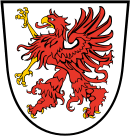

The name Pomerania comes from Slavic po more, which means "land by the sea".[1] The adjective for the region is (Western) Pomeranian (Polish: pomorski, German: pommersch), inhabitants are called (Western) Pomeranians (Polish: Pomorzanie, German: Pommern).
Forming part of the southern coast of the Baltic Sea, Western Pomerania's boundaries have changed through the centuries and it belonged to countries such as Poland, Sweden, Denmark, and Prussia. Before 1945, it embraced the whole area of Pomerania west of the Oder River. Today the cities of Szczecin (German: Stettin), Świnoujście (German: Swinemünde) and Police (German: Pölitz) are part of Poland (see Territorial changes of Poland immediately after World War II), with the remainder of the region staying part of Germany. German Vorpommern now forms about one-third of the present-day north-eastern state of Mecklenburg-Vorpommern.
German Western Pomerania had a population of about 470,000 in 2012 (districts of Vorpommern-Rügen and Vorpommern-Greifswald combined) - while the Polish districts of the region had a population of about 520,000 in 2012 (cities of Szczecin, Świnoujście and Police County combined). So overall, about 1 million people live in the historical region of Western Pomerania today, while the Szczecin agglomeration reaches even further.
Towns on the German side include Damgarten, Bergen (Rügen Island), Anklam, Wolgast, Demmin, Pasewalk, Grimmen, Sassnitz (Rügen Island), Ueckermünde, Torgelow and Barth.
Terminology
The German prefix Vor- denotes a location closer to the speaker, and is the equivalent of "Hither" in English and Citerior/Cis- in Latin (with the corresponding antonyms in German, English and Latin being Hinter-, "Farther" and Ulterior/Trans-, respectively). Historically the name "Hither Pomerania" has been used, but in modern English the German region is more commonly called "Western Pomerania" or by its native name. The local dialect term is Low German: Vörpommern.
The toponym Pomerania comes from Slavic po more, which means Land at the Sea.[1]
The Polish name for this region is Pomorze Przednie or Przedpomorze – corresponding to German Vorpommern – even though from the Polish capital's point of view the region is more distant than the rest of Pomerania. Poland has both a historic and geographic term Western Pomerania as well as a province (voivodeship) called West Pomerania, which comprises the western half of the Polish part of Pomerania.
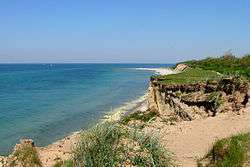
Geography
The major feature of Western Pomerania is its long Baltic Sea and lagoons coastline. Typical is a distinct "double coast", whereby offshore islands separate lagoons (so-called bodden) from the open sea, forming a unique landscape. The islands Rügen and Usedom are located in Western Pomerania
The largest town in Western Pomerania is Szczecin on the Polish side and Stralsund on the German side. Today it is still an important town economically. The towns of Stralsund and Greifswald together, after Rostock, are the second largest centres of population in Mecklenburg-Vorpommern. In addition the region has the highest population density of the four planning regions in the state.
Western Pomerania has two national parks:
- Jasmund National Park
- West Pomeranian Lagoon Area National Park
Another region in Western Pomerania under extensive conservation protection is the Peene Valley.
Administrative subdivisions
Vorpommern today is understood as comprising the islands of Rügen and Usedom and the nearby mainland, roughly matching the administrative districts of Vorpommern-Rügen and Vorpommern-Greifswald, though those districts' boundaries with Mecklenburg proper do not match the pre-1945 demarcation.
The region is mentioned in the Mecklenburg-Vorpommern state constitution as one of the two constituting regions of the state with the right to form a Landschaftsverband, which is an administrative entity subordinate only to the state level. Consideration was given during an unsuccessful district reform project in 1994 to restoring the old boundary, but this was not implemented. The Ribnitz, Marlow and Fischland area of Vorpommern-Rügen were historically part of Mecklenburg. The old western boundary line is preserved in the division between the two Protestant church bodies of the Evangelical Lutheran State Church of Mecklenburg (German: Evangelisch-Lutherische Landeskirche Mecklenburgs) and the Pomeranian Evangelical Church (German: Pommersche Evangelische Kirche).
Cities and towns
Major cities and towns in Vorpommern include Stralsund, Greifswald, Bergen auf Rügen, Demmin, Anklam, Wolgast, Sassnitz and Barth. Heringsdorf does not have city rights, but is a semi-urban center. With Polish entry into the European Union and the opening of borders, Stettin has resumed its place as a dominant city for southern and eastern parts of the region.
You can sort the table of the 20 largest towns by clicking one of the upper columns.
| City/Town | Coat of Arms | District | first mentioned | Town privileges | Area in km2 | Population at December 31, 2013[2] | Image |
|---|---|---|---|---|---|---|---|
| (Szczecin/Stettin) | 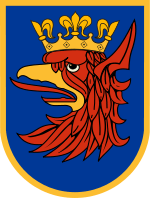 |
West Pomerania | 1243 | 301.30 | 408,105 | ||
| Stralsund |  |
Vorpommern-Rügen | 1234 | 1234 | 38.97 | 59421 | |
| Greifswald |  |
Vorpommern-Greifswald | 1241 | 1250 | 50.50 | 59382 | 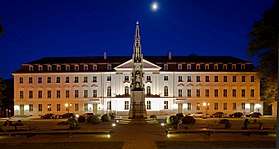 |
| Bergen auf Rügen |  |
Vorpommern-Rügen | 1314 | 1613 | 51.42 | 13460 |  |
| Anklam |  |
Vorpommern-Greifswald | 1243 | 1264 | 56.57 | 12385 | |
| Wolgast |  |
Vorpommern-Greifswald | 1123 | 1257 | 61.52 | 12028 | |
| Demmin | Mecklenburgische Seenplatte | 1070 | 1236[3] | 81.56 | 10657 |  | |
| Pasewalk |  |
Vorpommern-Greifswald | 1121 | 1251[4] | 54.99 | 10213 |  |
| Grimmen |  |
Vorpommern-Rügen | 1267 | 1287 | 50.29 | 9572 | 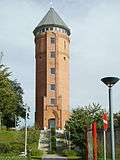 |
| Sassnitz |  |
Vorpommern-Rügen | 1906[5] | 1957 | 46.45 | 9320 |  |
| Ueckermünde |  |
Vorpommern-Greifswald | 1178 | 1260 | 84.69 | 8591 |  |
| Torgelow |  |
Vorpommern-Greifswald | 1281 | 1945 | 49.46 | 9153 | 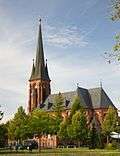 |
| Barth | Vorpommern-Rügen | 1255 | 1255 | 40.83 | 8658 |  | |
| Eggesin | Vorpommern-Greifswald | 1216 | 1966 | 88.01 | 4695 | ||
| Loitz |  |
Vorpommern-Greifswald | 1242 | 1242 | 89.53 | 4281 | 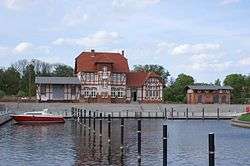 |
| Putbus |  |
Vorpommern-Rügen | 1810 | 1810 | 66.60 | 4364 | |
| Jarmen |  |
Vorpommern-Greifswald | 1269 | 1720 | 30.64 | 2942 | |
| Gützkow | 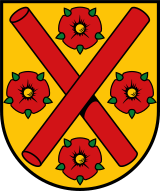 |
Vorpommern-Greifswald | 1301 | 1353 | 42.68 | 2965 | 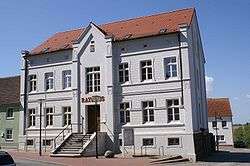 |
| Tribsees |  |
Vorpommern-Rügen | 1136 | 1285 | 54.75 | 2608 | |
| Garz/Rügen | Vorpommern-Rügen | 1207 | 1319 | 65.44 | 2194 |  | |
Economy
Popular tourist resorts can be found all along the Baltic beaches of the Fischland-Darß-Zingst peninsula and the islands of Hiddensee, Rügen and Usedom. The old Hanseatic towns are also popular tourist destinations due to their brick gothic medieval architecture, downtown Stralsund is a UNESCO World Heritage Site. Stralsund, Greifswald and Wolgast also have a shipyard industry, the Volkswerft in Stralsund and the Peenewerft in Wolgast produce large ships, while the HanseYacht shipyard in Greifswald is specialized in building yachts. In Mukran near Sassnitz on Rügen, there is an international ferry terminal linking Western Pomerania to Sweden, Denmark, Lithuania and other oversee countries. An industrial complex northeast of Lubmin near Greifswald includes a shut-down nuclear power plant which is being deconstructed, and the Nord Stream gas pipeline which come ashore at this site. In Greifswald, the University of Greifswald runs several institutions and the major hospitals of the region. Also, Greifswald is the site of innovative scientific research, like the Wendelstein physics research center and biotechnology enterprises, most notably the federal Friedrich Loeffler institute for animal diseases like BSE.
Away from the coastal tourist resorts, the rural areas of Western Pomerania have often maintained an agricultural character. A study published on 18 May 2009 revealed that the wealth situation of people in Vorpommern is on a mean range in Germany, with 27% of the population regarded as indigent - that is living with below 60% of an average German income.[6]
History
Era before 1121
In prehistoric times, the area was inhabited by megalith cultures. In the first half of the first millennium, the East Germanic Rugians[7] are reported in the area, who are known to later set up a kingdom far South in Pannonia in the 5th century.
By the 6th and 7th century, West Slavic people populated the region. If they met a substantial Rugian population and whether and/or how these were assimilated by the Slavs is not known. The Slavic inhabitants, also referred to as part of the Wilzen/Veleti, diverged into several small tribes, listed from Northwest to Southeast: The Rujanes or Rani around Rügen, the Circipanes around the Pane (Peene) River, the Redarians around the temple of Rethra, the Wollinians on the isle of Wolin, the Tollensians around the Tollense River and the Ukrainians around the Uecker River in the Uckermark. The collective term Liutizians also covers some of these tribes, as they allied in the late 10th century to secure their sovereignty. The Lutician alliances headquarters were at Rethra, where delegates from the independent allied tribes held their meetings. Whether or not the Rani were part of the Veleti or later the Lutizians is disputed. The Slavic tribes referred to as Pomeranians settled east of the Oder River.
In this era, large mixed Slavic and Scandinavian settlements were built at the natural havens of the bay-rich coast, the most important of which were Ralswiek (Rügen), Altes Lager Menzlin at the Peene River and Wolin, which is assumed to be identical with Vineta and Jomsborg. Important pagan temple sites were Arkona and Rethra. Other local strongholds were Dimin (Demmin) in the Circipan and Stetin (Szczecin) in the Pomeranian area.
At the beginning of the second millennium, western Pomeranian tribes were surrounded by the expanding states of Denmark in the North, Piast Poland in the Southeast and the German Holy Roman Empire in the Southwest. While the eastward expansion of the latter could be halted for some time by a Slavic uprising of the Southern (Heveller) and Western (Obotrites) neighbors of the western Pomeranian tribes, which even was supported by the Liutizian alliance, the Pomeranians East of the Oder River were conquered by the Polish state in the late 10th century and remained vassals of the dynasty of Piasts until 1007, had to pay tribute to the Poles after 1042, and were conquered again in 1121.
Duchy of Pomerania (1121/81–1637) and Principality of Rügen (1168–1325)
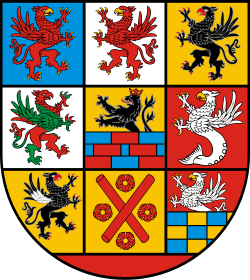
In spite of his surrender or even with military help from the succeeding Poles, the Pomeranian duke Wartislaw I of the House of Griffins successfully started conquering the areas west of his burgh in Stettin the years after 1121. These lands were considerably weakened by previous warfare: The coast was raided by the Danes, which destroyed Jomsborg in 1043, shifting the power in the Oder delta South to Pomeranian Stettin. Rethra was raided and devastated by the Germans in winter 1068/69, the Lutizian alliance fell apart, and instead the Lutizian tribes started fighting against each other ("Liutizischer Bruderkrieg", Liutizian civil war).
Wartislaw's aim was not only the expansion of his duchy, but also the spread of the Christian faith. In 1124, he invited Otto von Bamberg to mission in his duchy east of the Oder River. By 1128, Wartislaw I had expanded his duchy west to the County of Gützkow and Circipania and south to the Uckermark. He invited Otto von Bamberg again to mission in these pagan areas West of the Oder River, too. The former Liutizian principalities were turned into castellanies subordinate to the Pomeranian duke, who appointed the castellans. These castellanies were converted from their pagan to Christian religion in Usedom, 1128. Except for the Rani living North of the Ryck River and Demmin, all western Pomeranian territories had become united and Christian. Wartislaw's dependency on Poland loosened in the following years and, in 1135 with the death of Polish king Boleslaw III, Wartislaw's duchy regained independence. About ten years later, he was slain by pagans near Stolpe. Stolpe Abbey was erected at this site by Wartislaw's successor, Ratibor I.
The 1147 Wendish Crusade (German: Wendenkreuzzug) initiated by the Holy Roman Empire ended when the Demmin and Stettin citizens persuaded the crusaders that they were already Christians.
By the middle of the 12th century, the Principality of Rügen in northwestern Pomerania remained the last pagan state in Central Europe. In 1168, a Danish fleet led by Roskilde archbishop Absalon sacked Rügen. The Arkona temple was sieged and destroyed. After this main temple's fall, Rügen's capitol Charenza (Venzer Burgwall) capitulated, all other temples were given to the Danes for destruction and Jaromar I, Prince of Rügen became a Danish vassal. The Rani then converted to Christianity.
From Rügen, which still had a strong navy and army, the Danish put pressure on Pomerania. Bogislaw I duke of Pomerania made his duchy a part of the Holy Roman Empire (HRE) in 1181, after he had allied with Henry the Lion since 1164. So, Pomerania became the first Slavic duchy of the HRE. But the new alliance did not prevent the Danes from successfully raiding and in 1186 conquering all of Pomerania. Danish rule ended when in 1227 the Danish navy was defeated in Bornhöved by the Germans, Pomerania except for Rügen (until 1345 with the last Rugian duke's death) fell to the HRE.
Colonization and German settlement (since the 12th century)
The Rügen and Pomerania dukes called in many German settlers and aristocrats in order to resettle parts of their duchies devastated in the wars before and to settle new areas by turning woodland into fields. Settlers came from North German Lower Saxony. Some settlers from the Harz mountains in central Germany settled near Stettin. Cities and monasteries were founded. Between the 12th century and 13th century, Western Pomerania changed from a pagan and Slavic to a Christian and German country (Ostsiedlung). The Slavs (Wends) were first excluded from the villages and privileges of the German settlers. They later merged with the German majority. Western Pomerania then was part of the Duchy of Pomerania, the areas north of the Peene River (Principality of Rugia) joined the duchy in 1325.
From that time onwards, the region shares a common history with Farther Pomerania.
Swedish (1630/48–1720/1815) and Prussian province (1720/1815–1945)
Pomerania came under Swedish military control in 1630 during the Thirty Years' War. Swedish sovereignty over Vorpommern, including Stettin, was confirmed by the Peace of Westphalia (1648) and the Treaty of Stettin (1653), and from that time onwards much of the region formed Swedish Pomerania. Possession of this region remained an issue of conflict in European politics and Swedish rule was a period marked by the ravages of warfare.
A part of the region south of the Peene river (Old Western Pomerania or Altvorpommern) came under Prussian sovereignty after the Stockholm peace treaty in 1720. Under the Treaty of Kiel, the remnants of Swedish Pomerania (New Western Pomerania or Neuvorpommern) were briefly transferred to Denmark in 1814, but the 1815 Congress of Vienna ceded the territory to Prussia.
From 1815, all of Western Pomerania was integrated into the Prussian Province of Pomerania, administered as the Region of Stralsund (New Western Pomerania) and Region of Stettin (the old Western Pomeranian region). Stralsund was fused into Stettin in 1932.
Mecklenburg-Vorpommern (after 1945/90)
At the end of World War II in 1945, a small area of Vorpommern including Szczecin - the region's principal city - and Świnoujście was transferred along with Farther Pomerania to Poland. The bulk of Vorpommern became part of the newly constituted Land (state) of Mecklenburg-Vorpommern. The word "Vorpommern" was deleted from the state's name at the insistence of the Soviet military administration in 1947[8] and the entire state of Mecklenburg was abolished by East Germany (German Democratic Republic, GDR) in 1952. The Pomeranian districts were made part of the GDR's Bezirk Rostock (coastal region) and Bezirk Neubrandenburg, with a small area around Gartz becoming part of Bezirk Frankfurt/Oder.
The 1945–1952 state was reconstituted, with minor border adjustments, as Mecklenburg-Vorpommern at the time of German reunification in 1990. Vorpommern is a constitutional region of the state, yet not an administrative entity.
After the administrative reforms of September 2011, the bulk of Western Pomerania is within the districts of Vorpommern-Rügen and Vorpommern-Greifswald; however, some west central areas such as the Demmin area are within Mecklenburgische Seenplatte. In 2012, the Pomeranian Evangelical Church merged with the Mecklenburgian and Northalbingian Evangelical Churches.
See also
- List of towns in Vorpommern
- List of Pomeranian duchies and dukes
- West Pomeranian dialect
References
- Der Name Pommern (po more) ist slawischer Herkunft und bedeutet so viel wie "Land am Meer". (Pommersches Landesmuseum, German)
- MV Stats: Census results
- Town privileges given between 1236 and 1249
- unsettled date, definite town privileges at 1276
- merging of the fishing villages Saßnitz and Crampas
- Stern, 18 May 2009
- H. J. Janzen, History of Pomerania (in German)
- No author, timeline of state history
| Wikimedia Commons has media related to Western Pomerania. |
